Learning how to grow lettuce at home from seed is easy, fun, and an inexpensive way to enjoy fresh lettuce. If you like to eat a lot of lettuce you will appreciate being able to grow your own lettuce as there is no comparison of taste and flavor between the store-bought and your freshly picked homegrown lettuce.
Below, I will show you step by step how to plant, grow from seed, and harvest lettuce so you can have a tasty successful crop of lettuce all season long in your home garden!
JUMP TO:
- 1 How To Grow Lettuce At Home
- 2 Soil Conditions For Lettuce
- 3 When To Plant Lettuce
- 4 Lettuce Seed Germination Time
- 5 How To Plant Lettuce Seeds
- 6 Planting Lettuce Seeds Directly Outdoors
- 7 How To Start Lettuce Seeds Indoors
- 8 Transplanting Lettuce Plants
- 9 Succession planting lettuce
- 10 How to harvest lettuce plants
- 11 How big can a homegrown loose-leaf lettuce variety get?
- 12 FAQs
How To Grow Lettuce At Home
Lettuce is a great vegetable for all gardeners including beginners as it grows quickly, can have a long harvesting time, and is pretty much maintenance-free once it starts growing along. It is also a great choice for gardeners with a small space for growing as it can be grown in pots or containers as well.
Lettuce will grow best in the spring and fall during the cooler temperatures but can also survive in the summer months if it can get some afternoon shade. You can also look for slow bolting lettuce varieties to plant for the summer months as well as use shade cloth.
To enjoy lettuce continuously throughout the whole growing season, you will need to do what is called succession planting. This means in a couple of weeks you will start to sow some more lettuce seeds.
Types of Lettuce Seeds You Can Plant
There is a lot of different varieties of lettuce seeds that you can choose from. Here are a few of the main types of lettuce that you can buy:
- Butterhead lettuce or Bibb lettuce are round loose lettuces that have large delicate leaves. They make an excellent choice for making lettuce wraps because of their larger leaves. A few favorites are Buttercrunch and Roxy. I like growing the buttercrunch variety because my family really enjoys its flavor. I like that the leaves get quite large and are a bit thicker texture than the loose-leaf variety.
- Iceberg lettuce grows and forms into a firm-formed head with high water content. This variety is known for its nice crisp texture. A quick-growing iceberg variety is Dillon, it can be ready to harvest in as little as 45 days!
- Loose-Leaf varieties produce open heads with leaves that can easily be picked individually even when they are small-sized. Grand Rapids is an all-time winner as well as Red Sails which has deep bronze wavy leaves.
- Romaine Lettuce will grow into an upright head with broad crisp leaves. Romaine lettuce will withstand the summer heat better than the other varieties. A few favorites are the Coastal Star and the Arroyo.
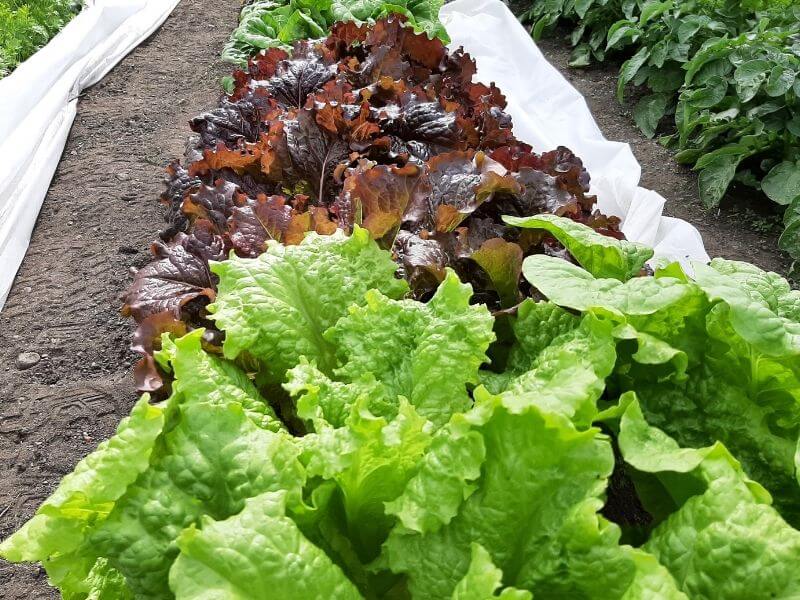
How to grow lettuce at home – A beautiful row of healthy red and green leaf lettuce planted in the garden
Soil Conditions For Lettuce
All lettuce plants like fertile, moist, and well-drained soil conditions with a pH between 6.0 – 7.0. Lettuce plants do the best with a full 6 hours of sunlight so you will need to find an area in your garden that will supply them with that amount of sun.
Lettuce plants are fast growing so you will need to prepare your soil area with some well-aged manure or some good organic compost. If you do not have any manure or compost available you can also use a granular slow-release fertilizer, just sprinkle some on top of the soil and work in.
When To Plant Lettuce
You can begin to sow lettuce seeds straight into the ground as soon as there is no risk of the last frost and your soil becomes workable in the early spring. This will vary depending on what gardening zone you are in. In my gardening zone 4b that usually means after the May long weekend.
You can sow seeds sooner if you have a way of protecting the lettuce from frost that may occur. You can use frost row covers that are made from a breathable cloth that allows sunlight and rain to get through but helps to trap the heat in. You can also use a cold frame for earlier planting.
Lettuce Seed Germination Time
Depending on soil temperature conditions, lettuce seeds will generally start sprouting in 5-10 days. As temperatures warm up during the summer months of hot weather lettuce seeds tend not to germinate as easily. You can germinate the lettuce seeds in a cooler spot.
How To Plant Lettuce Seeds
You can plant your lettuce seeds by two different methods.
- Transplant young plants that you have bought at a garden center or have started yourself and then transplant your seedlings into your garden or pots.
- You can direct sow your seeds into your garden, raised beds, or into your pots and containers.
Planting Lettuce Seeds Directly Outdoors
Select a spot in your garden that gets a decent amount of full sun. Partial shade will also work for lettuce. Lettuce loves fertile soil so you will need to mix in some compost to your soil. Be sure to remove all weeds. Make shallow rows and sow 3 lettuce seeds together spaced about 12 inches apart.
Cover seeds so they are only 1/4 inch deep in the soil. Spray seeded area so that the dirt is moistened. Lettuce seeds germinate in 7-10 days. Keep the garden soil damp until leaves pop up.
How To Start Lettuce Seeds Indoors
I now start my lettuce seeds indoors as my growing season is short and now I can start enjoying fresh lettuce 4 – 6 weeks earlier. Be sure you harden them off first before planting them permanently in your garden location. Be sure to keep your soil moist and don’t let it dry out.
What you will need for starting lettuce seeds indoors:
- Seeds
- Seed Tray
- Seed Starting Soil Mix
- Water
- Grow lights
Step 1 – Place the seed starting soil mix into the seedling trays. You can premoisten the soil before adding to trays or water after.
Step 2 – If you are using trays with small cells then you will only want to add one lettuce seed to each cell. If you are using larger-sized containers or cells then add more accordingly but don’t overcrowd as your seedlings will be smaller. Do not plant seeds too deep keep them to 1/4 inch depth.
Step 3 – Lightly water your trays evenly until you have moist soil.
Step 4 – Cover your trays with the clear plastic dome that they came with and place them in a sunny window. If you do not have a dome to cover with you can use a clear plastic bag. You will want to keep them in an area where the temperature is between 65 – 75 degrees. Remove the cover once the lettuce leaves have started to grow up.
Step 5 – Keep your lettuce trays in bright light or use a grow light over them to keep them from getting leggy. Water your lettuce seedlings regularly and don’t let them dry out. You can fertilize the lettuce after a couple of weeks of growth to help them out and keep them green.
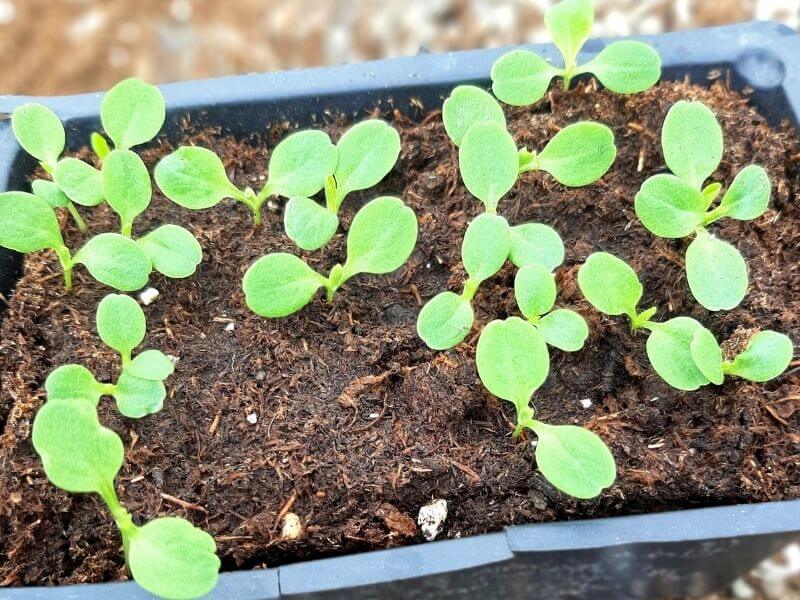
lettuce seedlings sprouting up in a planted container
Transplanting Lettuce Plants
If you have bought lettuce seedlings or have started your own at home you will need to harden them off before planting directly outside. You could risk losing your seedlings if just planted outside especially if it is sunny and warm weather.
Once the lettuce plants are hardened off they are ready to be planted in your garden or raised bed. The best time to plant them is in the late afternoon. I find that this is best as they have all night and morning to settle in. You can sprinkle some organic slow-release fertilizer into the top inch of soil where you are going to place your lettuce or organic matter if you have.
If you are transplanting your seedlings into rows you will want to space each seedling 10-12 inches apart from each other and about 12 inches wide from each other. Be sure to check the seed packet on the spacing dimensions. I find this works well as it gives each lettuce room to grow new leaves and expand while giving you room to go in and cut off the outer leaves.
I like to use my seedling stick to make the holes to place my lettuce plants in. You can use the end of your garden hoe or use a handheld spade to create the space needed. I like to add water to the holes before placing my lettuce seedling in. That way you know the roots will get a good drink.
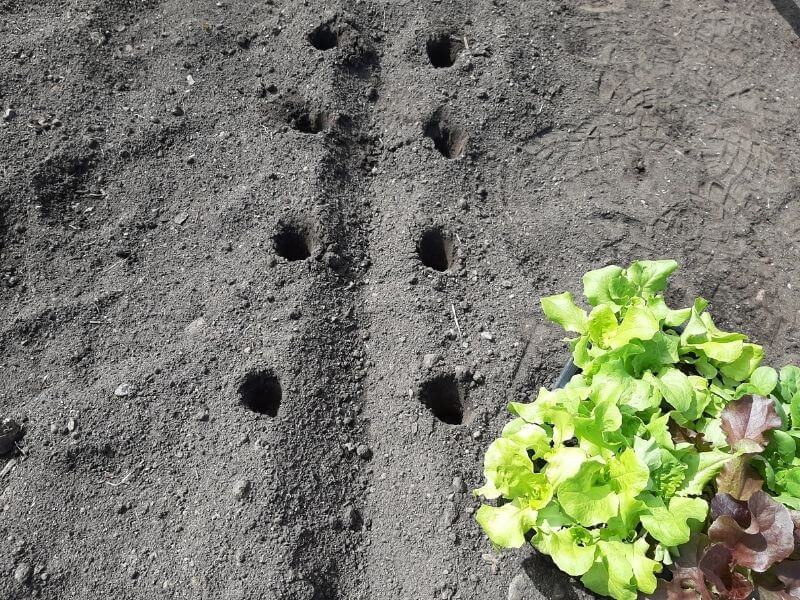
Spaced out holes ready for lettuce seedlings to be planted in the garden
Gently pull apart your lettuce seedlings apart so you have one individual lettuce plant, taking care not to rip the roots. Place your lettuce seedling into the hole you have made for it making sure all the lettuce roots are placed into the hole and are facing down.
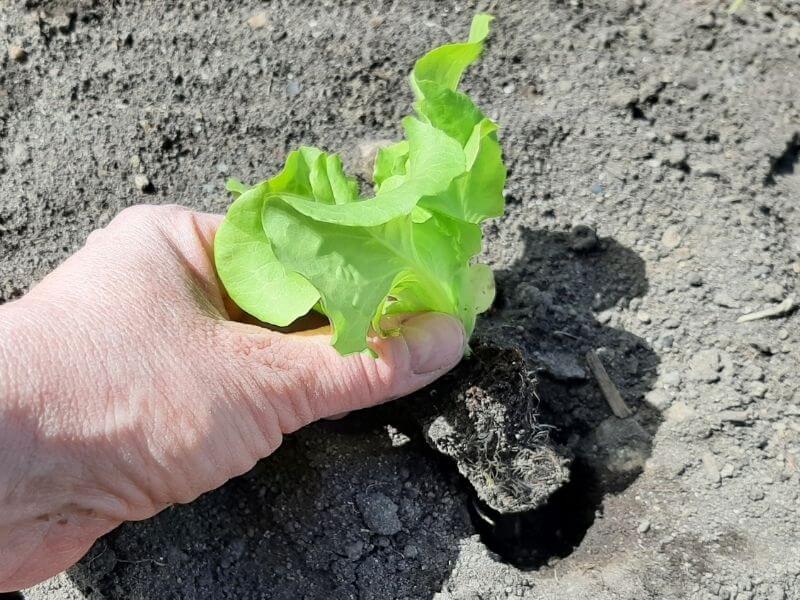
Transplanting lettuce seedlings into ready-made holes in the garden
Cover it up with dirt to just below the bottom leaves and gently pat it so it stays upright. Continue until all your lettuce seedlings are planted. Water all the seedlings one more time so the surface area is wet.
If it is going to be a warm afternoon I will cover my plants with some light reemay or row cover cloth for protection.
In about 2 weeks’ time, your lettuce seedlings may need to be thinned out to allow room for larger-sized heads of lettuce to grow. You can just pull the whole plant with the root out. Wash and eat these lettuce thinnings.
- Lettuce seedlings transplanted into a raised bed
- Lettuce seedlings transplanted into a garden
Succession planting lettuce
The secret to having fresh lettuce all season long is succession planting! Succession planting is planting more seeds at every 2 – 3 week interval. This will give you a non-stop supply of lettuce for the whole season.
How to harvest lettuce plants
When you see your lettuce plants coming along nicely, you’re probably wondering when is it time to start harvesting so you can finally enjoy your fresh lettuce leaves. Here are some ways that you can start enjoying your lettuce harvest:
- If you have planted a thicker lettuce crop you can harvest the whole lettuce plant to help thin out your lettuce area to make room for the other lettuce plants to get larger.
- Harvest the outer leaves of lettuce plants that are spaced out and they will keep growing and you will have a cut and grow again harvest for up to 7 – 8 times!
- You can harvest the whole lettuce head when large enough just above the soil level.
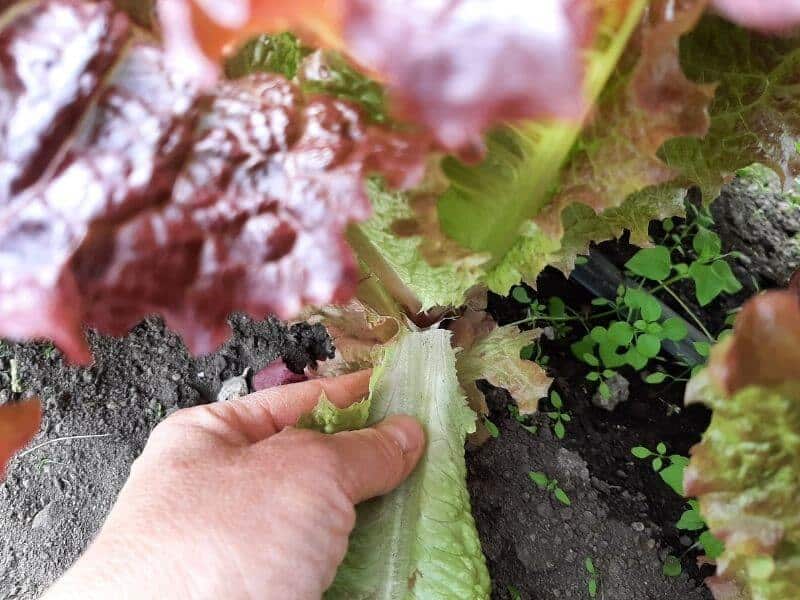
Harvesting outer leaves of loose leaf lettuce plants
How big can a homegrown loose-leaf lettuce variety get?
As you can see in the picture below, some varieties of loose-leaf lettuce can get quite large! That is my hand besides if for comparison.
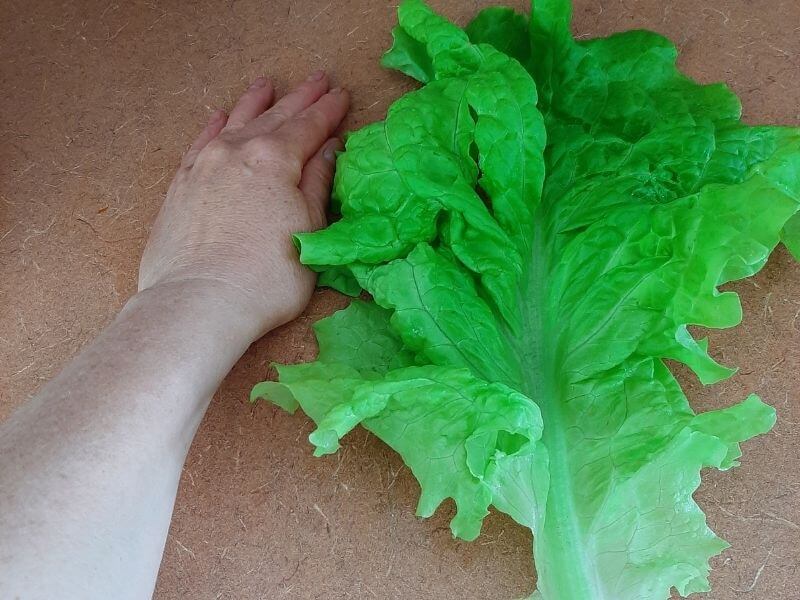
A very large loose-leaf lettuce leaf!
FAQs
How long does it take lettuce to grow from seed?
Lettuce seeds grow quite quickly and the loose leaf lettuce varieties can be harvested as baby leaves. This can be anywhere from 20-30 days. The average for maturity is 40-50 days. Larger lettuce varieties that produce a large lettuce head will need a longer time to mature and that can up to 80 days.
Be sure to read the back of your seed package to see the maturity of your variety of lettuce.
How Big Should Lettuce Seedlings Be Before Transplanting?
For best results, you will want your lettuce seedlings to be about 2 – 3 inches tall before transplanting them into their permanent home. If they are too small then you will risk losing them or could damage the delicate roots when transplanting.
Now you know everything there is on how to grow lettuce at home like a pro! Now let’s get planting!
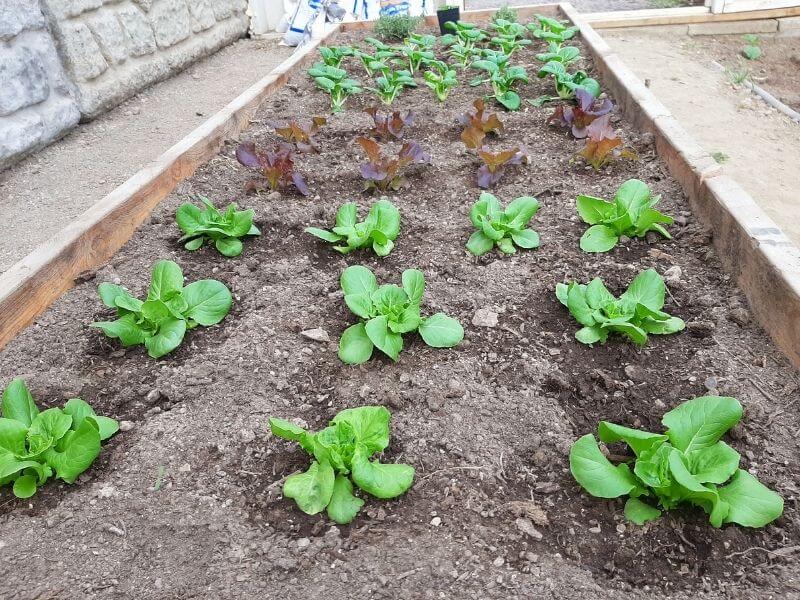
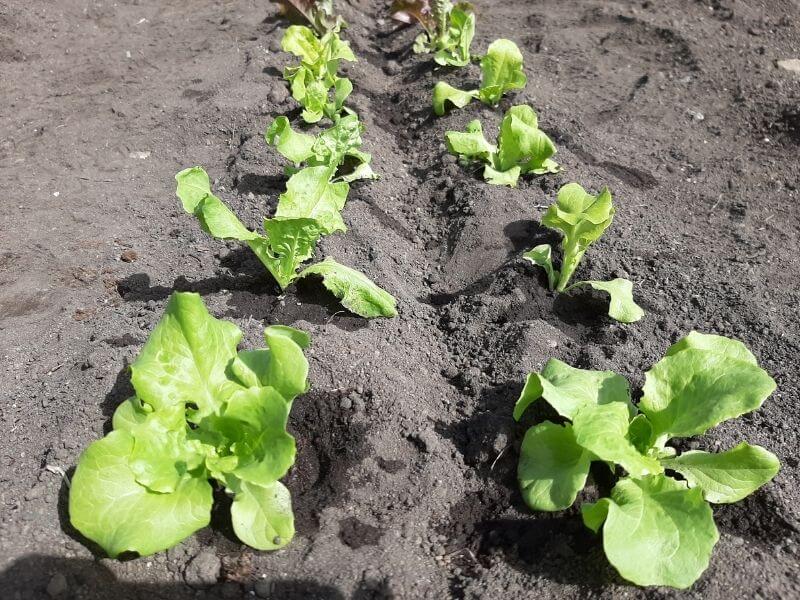
Leave a Reply